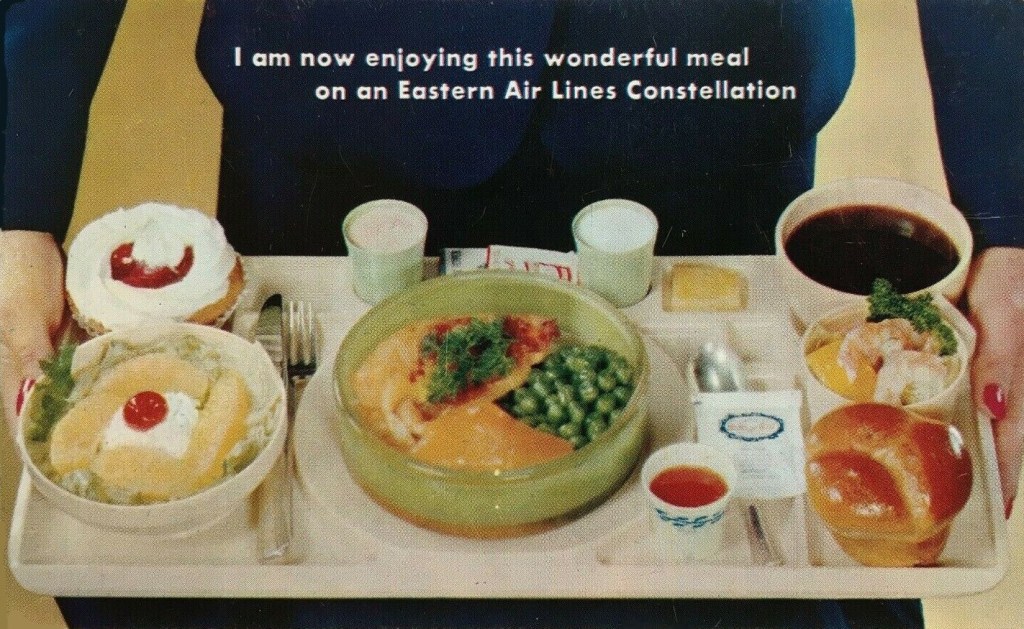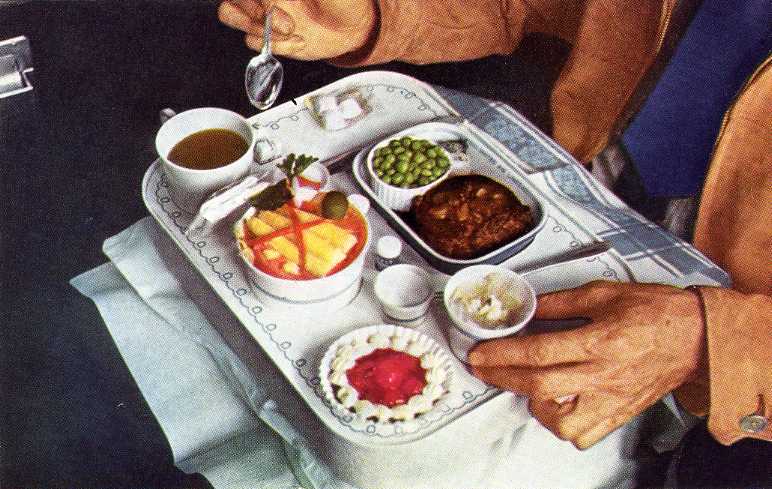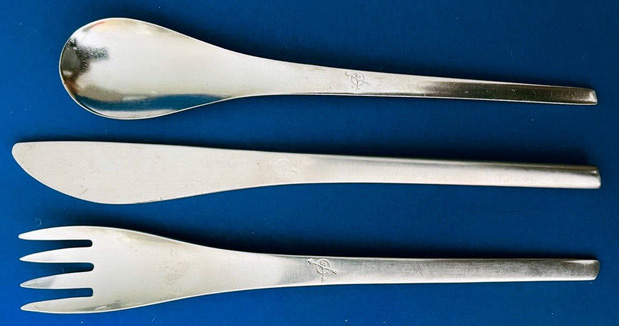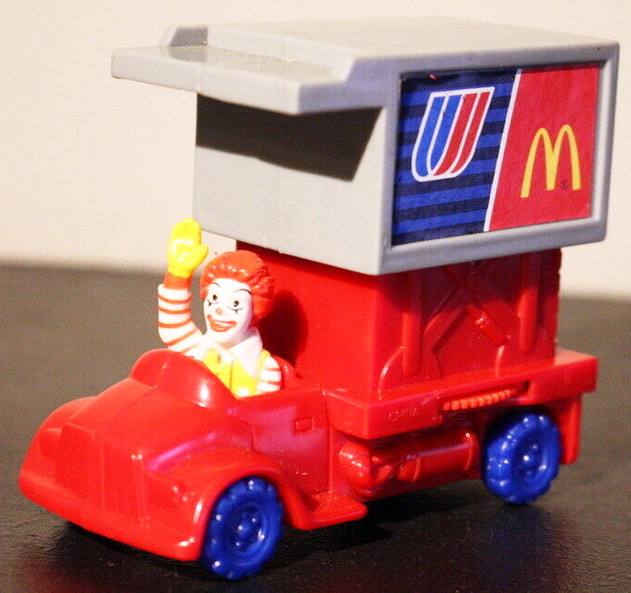After the early years of serving cold box lunches, U.S. airlines tried to improve their in-flight food service, sometimes through alliances with restaurants and restaurant chefs. As early as the 1930s, the decade in which transcontinental flights began, hot meals were becoming common. In 1939 George Rector, formerly of the swank and swinging Rector’s of pre-prohibition Broadway in New York City, advised Braniff Airways on their menus. He gave his blessing for a Thanksgiving menu that year that included roast turkey with oyster sauce and chestnut dressing, pickled watermelon rind, and other select dishes.
It’s fair to ask why airlines switched from cold box lunches, given how difficult and expensive it was to provide full-scale hot meals. A large part of the answer is that in the beginning they wanted to distinguish themselves in comparison with train travel. Over time, though, planes would become bigger and faster, offering cheaper fares and attracting many more passengers. Through all of this, meals would go from an attraction to a target for cost reduction.
It’s hard to know exactly what Rector’s role entailed. It may have been devising menus and training chefs rather than getting his hands dirty. Decades later that was probably equally true of another well-known chef, Wolfgang Puck of Spago in Los Angeles. In 1983 he advised luxury Regent Air Corp. on suitably impressive meals for its flights between LA and Newark. After being delivered to the airport via Regent’s limousine, passengers were treated to Beluga caviar, smoked salmon, and lobster fresh from Maine, washed down with fine wines. Within three years the airline had racked up $36 million in debt and was sold.
United Airlines was one of the few airlines that maintained their own flight kitchens. Starting in 1947 they were headed by Swiss chefs. Trained in European kitchens, they came to United with experience in major hotels and restaurants in the capital cities of Europe and America. Nonetheless United’s menus, whether in English or Franglais, were less than thrilling, especially when the various courses were all grouped together on a tray as depicted on this late 1960s postcard. Even though I’ve seen many United menus, I remain stumped about the ingredients in the “salad” that look remarkably like asparagus spears reposing on a bed of orange gelatin (though, to be fair, I’ve never seen gelatin on a United menu).
There were no Swiss chefs at the D.C. area’s Hot Shoppes drive-ins in 1937 when that company began to supply Eastern and Capital airlines with in-flight meals. Eventually the Hot Shoppes would become the Marriott Corp., a major airline caterer that became one of the largest, as did another that evolved from a restaurant chain, Dobbs House.
Meals in the 1950s may have been somewhat ho-hum (despite the fact that almost all flights were still first class only), but alcoholic beverages brightened the trip for some passengers. Despite the failed efforts of Senator Strom Thurmond of South Carolina, who introduced legislation in 1957 to outlaw the sale of alcohol on airplanes citing both safety and moral issues, nine domestic airlines began serving it in the 1950s, and the number grew from there. [Above, Delta, 1959]
Two free drinks became an attraction offered by a number of airlines as they ramped up their meals. Competition in cuisine became intense among the major carriers in the 1960s, in some cases involving the participation of fine, or at least famous, restaurants. This was perhaps inspired by Pan Am who recruited Maxim’s to supply meals for flights departing from Paris. Soon airlines in the U.S. began to conjure intriguing flight names such as Famous Restaurant Flights, Captain’s Table, and Royal Dining Service. American Airlines enlisted “21″ to supply flights leaving NYC, while Eastern – once catered by the Y.M.C.A. – signed up the elite Voisin for first-class flights from New York and the Pump Room for those from Chicago. Eastern discarded its humdrum serving pieces [at top of page] of old for Rosenthal china and stylish silverware [shown below]. As a commentator said in 1967, “ Practically every airline worthy of the name also calls itself a flying five-star restaurant.” [above, Voisin chefs preparing food for Eastern Airlines, 1965]
The peak of competition in food probably occurred in the early 1970s, when airlines offered champagne breakfasts, a variety of hors d’oeuvres, lobster plus steak dinners, and prime rib sliced on a rolling cart for each guest — ditto for displays of salad tossing. Passengers could request special meals designed to suit taste, health, or cultural/religious requirements.
Through all of this, though, there were always complaints about food. Almost everyone agreed that warmed-up meals could never match good home cooking or fine restaurant fare. And, of course, there were those who preferred to make their own arrangements and have the cost of meals subtracted from the cost of their ticket.
They got their wish in 1978 with the passage of the Airline Deregulation Act. Airlines were freed to compete in terms of fares and routes. New airlines were created. Some old ones grew mightier while others, such as Braniff and Eastern, disappeared in the 1980s recession. “Frills” were eliminated. Snack packs came into being, making the sandwich and apple of the 1930s seem almost generous. In the 1990s United began offering McDonald’s meals for children.
While hot meals did not completely disappear, they tended to be limited to first class passengers whose proportionate numbers had shrunk drastically since the 1950s. Today, meals by foreign carriers get the highest ratings.
© Jan Whitaker, 2022








 It's great to hear from readers and I take time to answer queries. I can't always find what you are looking for, but I do appreciate getting thank yous no matter what the outcome.
It's great to hear from readers and I take time to answer queries. I can't always find what you are looking for, but I do appreciate getting thank yous no matter what the outcome.



Love your blog! I just turned 22 and started studying chef school here in sweden where I live. I do a paper on womens history in the restaurant business. It’s unfortunately so hard to find information about women in swedish restaurant history, but I hope to write a good essay about it. I love reading your posts about american restaurant history. Your work is so important. Thank you!
Thanks so much, and good luck with your paper.
Lots of memories here. I remember dressing up in nice clothes (including pantyhose) to get on an airplane. I remember the metal cutlery (we still have a few filched pieces). Those little trays, those tiny containers. I always enjoyed it, even if the food was indifferent. It represented the beginning of an adventure.
Is that Ray Wise in the Eastern Airlines ad? Is he immortal?
That’s funny, but I think you mean the Delta ad? That was from 1959, so if he was born in 1947 as reported on the internet he would have been 12 then. It does look like him though.
Isn’t it interesting that in the three photos showing meals, there is always a round dessert-like item with whipped topping piped around the edge! Some things never change. Your emails and website/blog are always so interesting and well researched. Thank you for all you do!
The round desserts are striking. Thanks for your comment!
The first time I flew, the stewardess asked if I wanted dinner. I assumed it was not free so I said no. Bummer. I remember a cold chicken snack in a basket with a red and white checked napkin going between st louis and chicago. You’re only in the air 30 minutes between st louis and chicago. those poor hostesses. mb ________________________________
Great info!